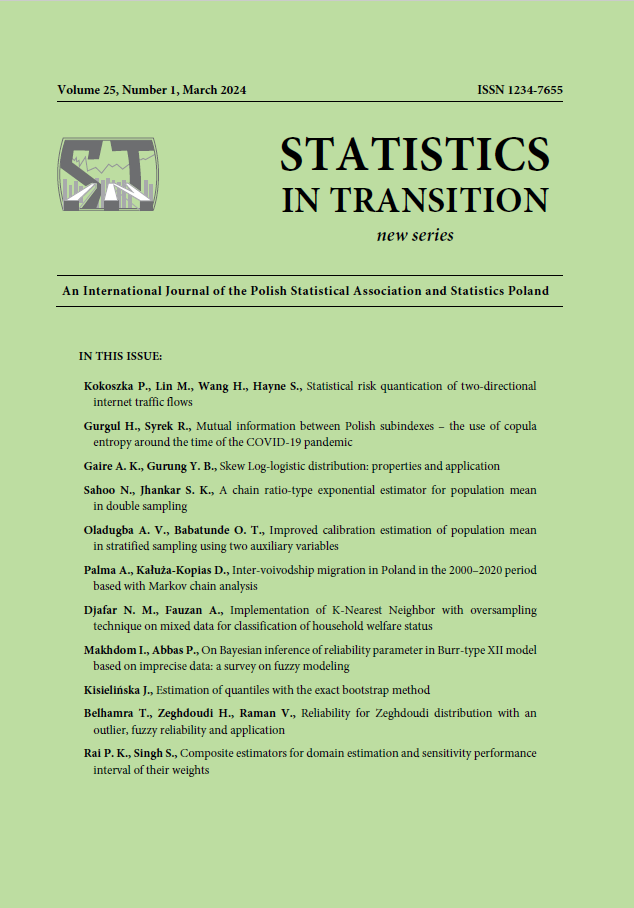ARTICLE
ABSTRACT
Some composite estimators based on various combinations of two different existing estimators are obtained for domain estimation. The estimation of weights and thus obtaining optimum weights to combine two or more different existing direct and indirect estimators to form composite estimators are not an easy task for practitioners due to many reasons. To account for the absence of optimum weights, we obtained the sensitivity performance intervals for weights with respect to the proposed composite estimator. Subsequently, we determined the sensible values of the involved weights. The aim of this procedure was to confine the superiority for different composite combinations i.e., simple direct vs. direct ratio, simple direct vs. synthetic ratio and direct ratio vs. synthetic ratio composite estimators as compared to the existing estimators.
KEYWORDS
domain estimation, synthetic and composite estimation, optimum weight, sensitivity performance interval.
REFERENCES
Agrawal, M. C., Roy, D. C., (1999). Efficient Estimators for Small Domains. Journal of the Indian Society of Agricultural Statistics, 52(3), pp. 327–337.
Ghosh, M., Rao, J. N. K., (1994). Small Area Estimation: An Appraisal. Statistical Science, 91, pp. 55–93.
Gonzalez, M. E., (1973). Use and Evaluation of Synthetic Estimates. Proceedings of the Social Statistical Section of American Statistical Association, pp. 33–36.
Hedayat, A. S., Sinha, B. K., (1991). Design and Inference in Finite Population Sampling. John Wiley & Sons, New York.
Holt, D., Smith T. M. F., and Tomberlin, T. J., (1979). A Model-Based Approach to Estimation for Small Subgroups of a Population. Journal of the American Statistical Association, 74, pp. 405–410.
Kalton, G., Flores-Cervantes, I., (2003). Weighting Methods. Journal of Official Statistics, 19(2), pp. 81–97.
L. Kung-Jong, (2020). Notes on Use of the Composite Estimator: an Improvement of the Ratio Estimator. Journal of Official Statistics, 36(1), pp. 137–149.
Pandey, K. K., (2010). Aspects of Small Area Estimation Using Auxiliary Information. VDM Verlag Dr.Muller e.K.
Pandey, P. S., Kathuria, O. P., (1995). Some Composite Estimators for Small Area Estimation. Journal of the Indian Society of Agricultural Statistics, 47(3), pp. 262– 272.
Platek, R., Rao, J. N. K., Sarndal, C. E., and Singh, M. P., (1981). Small Area Statistics: An International Symposium. John Wiley & Sons, New York.
Purcell, N. J., Kish, L., (1979). Estimation for Small Domains. Biometrics, 35, pp. 365– 384.
Rai, P. K., Pandey K. K., (2013). Synthetic Estimators Using Auxiliary Information in Small Domains, Statistics in Transition-new series, 14(1), pp. 31–44.
Rao, J. N. K., (2003). Small Area Estimation. Wiley Inter-Science, New Jersey, John Wiley and Sons.
Sarndal, C. E., Swensson, B., and Wretman, J., (1992). Model assisted survey sampling. Springer-Verlag.
Schaible, W. L., (1979). A Composite Estimator for Small Area Statistics. Synthetic Estimates for Small Areas:Statistical Workshop Papers and Discussion, National Institute on Drug Abuse (NIDA) Research Monograph 24, pp. 36–53.
Tikkiwal, G .C., Ghiya, A., (2004). A generalized Class of Composite Estimators with Application to Crop Acreage Estimation for Small Domains. Statistics in Transition, 6, pp. 697–711.
Tikkiwal, G. C., Rai, P. K., (2009). A Composite Estimator for Small Domains and its Sensitivity Interval for Weights ?. Statistics in Transition, 10(2), pp. 269–275.
